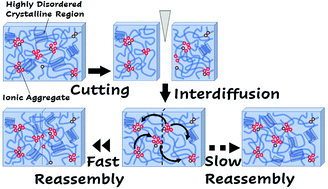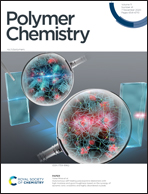Autonomous self-healing polyisoprene elastomers with high modulus and good toughness based on the synergy of dynamic ionic crosslinks and highly disordered crystals†
Abstract
Herein, we designed a novel polyisoprene (PI) elastomer with high mechanical properties and autonomous self-healing capability at room temperature facilitated by the coexistence of dynamic ionic crosslinks and crystalline components that slowly reassembled. We prepared amorphous cis-PI and semicrystalline trans-PI that were ionically modified with partially sodium-neutralized carboxy groups; a small amount (less than 30 wt%) of ionic trans-PI was blended with the ionic cis-PI. Nanosized ionic aggregates in the elastomers were formed by the ionic groups and they acted as physical crosslinks; the ionic network continuously rearranged at room temperature. We found that the crystalline components formed in the blended elastomers exhibited a higher degree of internal disorder owing to the miscibility of cis- and trans-PIs despite having different stereoregularities. The highly disordered crystalline components served as extra physical crosslinks that reinforced the material's mechanical strength: the modulus of the blended elastomer containing the ionic trans-PI (30 wt%) was 28 MPa at room temperature, whereas the neat ionic cis-PI was 1.2 MPa. Cut pieces of the blended elastomers reconnected at room temperature, and their self-healing efficiency was comparable to that of the neat ionic cis-PI at a trans-PI concentration below 20 wt% despite their improved moduli. Fourier transform infrared analysis revealed that the highly disordered crystalline regions in the blended samples were destroyed at the damaged faces. When the composition of the ionic trans-PI was lower than 20 wt%, the reassembly of the highly disordered crystalline regions at room temperature was slow compared with the interdiffusion process of the polymer chains between the damaged faces, and thereby self-healing was not disturbed.



 Please wait while we load your content...
Please wait while we load your content...